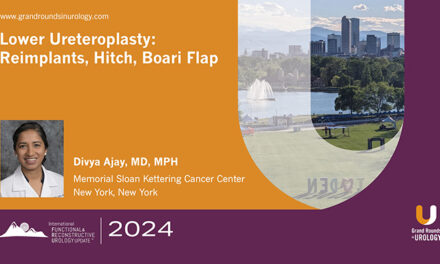Andrew Vickers, PhD, presented “Away from the Gleason Score and Towards Quantification of Pattern 4 for Treatment Decision Making in Localized Prostate Cancer” during the 8th Global Summit on Precision Diagnosis and Treatment of Prostate Cancer on October 8, 2024.
How to cite: Vickers, Andrew. “Away from the Gleason Score and Towards Quantification of Pattern 4 for Treatment Decision Making in Localized Prostate Cancer.” October 8, 2024. Accessed Jul 2025. https://grandroundsinurology.com/away-from-the-gleason-score-and-towards-quantification-of-pattern-4-for-treatment-decision-making-in-localized-prostate-cancer/
Away from the Gleason Score and Towards Quantification of Pattern 4 for Treatment Decision Making in Localized Prostate Cancer – Summary
Dr. Andrew Vickers, PhD, Professor of Healthcare Policy and Research at Weill Cornell Medical College and member of the Memorial Sloan Kettering Cancer Center, Department of Epidemiology and Biostatistics in New York, NY, delivers a nine-minute presentation on the need for reforming the Gleason score, which remains the cornerstone of decision-making in localized prostate cancer management. He highlights that while the Gleason grading system accurately describes histologic patterns, the scoring system, developed in 1967 and unchanged since, is outdated. Originally designed around six-month survival, it inadequately reflects modern clinical contexts and misrepresents risks, particularly in patients within grade groups 2 to 4.
Dr. Vickers critiques the reliance on ratios of Gleason patterns 3 and 4, which often yield illogical classifications. He emphasizes that the absolute quantity of pattern 4 correlates better with adverse oncologic outcomes, such as metastasis and advanced pathology. Data from multiple institutions, including Memorial Sloan Kettering and international centers, consistently show that quantifying pattern 4 outperforms the Gleason grade group in risk stratification.
Dr. Vikers notes variability among pathologists in measurement methods, limiting standardization. To address this, Dr. Vickers proposes leveraging AI to analyze digitized biopsy slides, refining the quantification process, and identifying optimal predictive models based on oncologic outcomes.
The Global Summit on Precision Diagnosis and Treatment of Prostate Cancer is a unique multi-disciplinary forum organized to inform the key health care stakeholders about the emerging advances in clinical case and research and create a consensus-based vision for the future of precision care and educational and research strategy for its realization. The mission of the Summit is to fill the currently existing gap between the key experts of in vivo imaging, the world authorities in the in vitro fluid- and tissue-based molecular diagnostics, including genomics, and thought leaders in the development of novel observation strategies (e.g., active surveillance, or AS) and therapeutic interventions.
ABOUT THE AUTHOR
Andrew Vickers, PhD, is an Attending Research Methodologist at Memorial Sloan Kettering Cancer Center in New York City. He is also Co-Director of the PRO-CEL Core Facility. Dr. Vickers’ research falls into three broad areas: randomized trials, surgical outcomes research and molecular marker studies. A particular focus of his work is the detection and initial treatment of prostate cancer. Dr. Vickers has analyzed the ‘learning curve’ for radical prostatectomy. He is working on a series of studies demonstrating that a single measure of prostate specific antigen (PSA) taken in middle age can predict lethal prostate cancer up to 30 years subsequently. He has also developed a statistical model to predict the result of prostate biopsy, work that has been commercialized and is clinically available through Opko Diagnostics. He is a course leader for the Memorial Sloan Kettering biostatistics course and is the author of the statistics textbook What is a P-Value Anyway?




